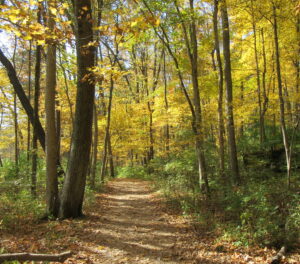Middle fall typically occurs in November across the South, in October along the 40th Parallel, and in September east of the Rocky Mountains along the Canadian Border.
Autumn deepens: Streaks of scarlet appear on the oaks, shades of pink on the dogwoods. Shagbark hickories, tulip trees, elms, locusts and sweet gums change to full yellow or deep maroon. Sassafras leaves are old and tarnished, blackberry leaves purple, sumac bright red. Grape vines are bleached with age. The bare black walnut trees display then drop their fruit. Ironwood sheds quickly. Locust leaves drizzle steadily to the undergrowth. Mountain ash is thinning, its orange berries more prominent. Hawthorn berries redden. In shades of burgundy, poison ivy and Virginia creeper outline all the changes.
Almost every hummingbird has gone to the Gulf as middle fall approaches. Terns and meadowlarks, yellow-rumped warblers and martins migrate. Hawks move south, stalking the migrants, resting on fences and high wires to look for prey. Robins give their clucks and whinnies, guiding each other as they gather and move along the rivers. The first slate-grey junco arrives in the Ohio Valley for winter. Long flocks of blackbirds and grackles fly overhead, their passage often lasting several minutes. Sometimes they settle into trees and join the starlings that have come together once again for winter; they and caw and cackle throughout the day.
Cabbage white and painted lady butterflies replace the swallowtails and monarchs. Aphids disappear in the chilly nights. Cicadas die. Japanese beetles complete their season. Daddy longlegs disappear from the undergrowth. Damselflies are rare along the rivers now, and darners have left their ponds. The last huge silver webs of the orb weavers hang in the brittle wingstem, shine in morning sun. Most of the bumblebees and carpenter bees have retired for the year. Yellow jackets seek the fallen apples. The preying mantises hunt and mate, laying their eggs in protective oothecas.
As the canopy thins above them, the tall sedums relinquish their petals, and autumn crocuses die back. Thimble plants and the first milkweed pods unravel. The jumpseeds and touch-me-nots send out their final seeds. Toothed beggartick leaves darken overnight, and their burrs stick to the fur of your dog or to your clothing. Along the highways, tall goldenrod is greying as farmers cut their corn and soybeans. Through the woods, blue-stemmed goldenrod, Short’s aster and the small-flowered asters still blossom at the far side of their seasons, but New England asters and Jerusalem artichokes suddenly die back in byways and in village gardens. Ironweed seeds become brown and soft. Hobblebush leaves become pale, wood nettle creamy white, avens a golden green. Euonymus berries are white, privet berries blue.
Bill Felker

